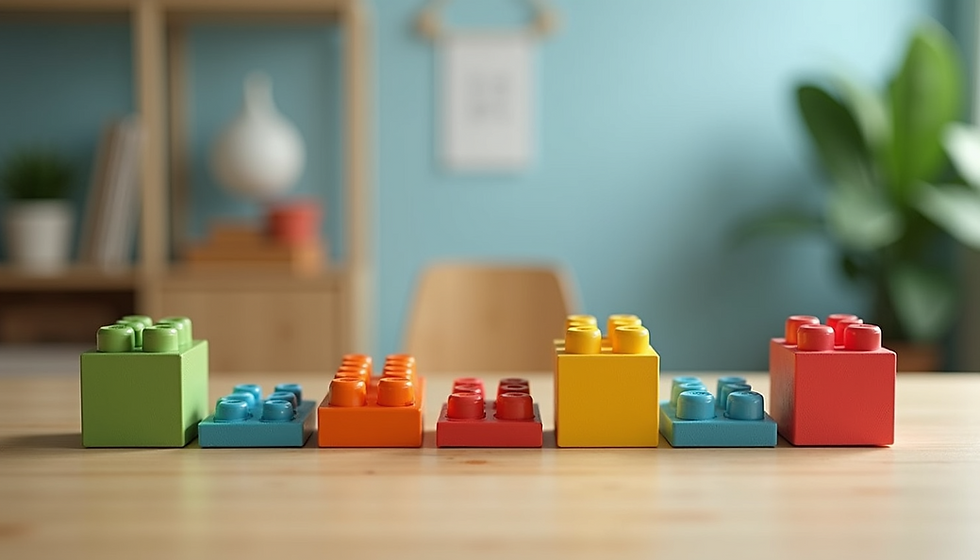Top 10 Educational Toys for Early Development
- Tine Genius Play Expert
- Nov 2
- 3 min read
Early childhood is a critical time for brain growth and skill development. Choosing the right toys can make a big difference in how children learn and explore the world around them. Educational toys encourage creativity, problem-solving, and motor skills, all while keeping playtime fun. This post highlights ten of the best educational toys that support early development, helping parents and caregivers make informed choices.

Why Educational Toys Matter for Early Development
Toys are more than just entertainment. They serve as tools that stimulate a child’s mind and body. During early years, children develop language, coordination, social skills, and cognitive abilities. Educational toys provide opportunities to practice these skills in an engaging way. For example, puzzles improve problem-solving, while shape sorters teach spatial awareness.
Selecting toys that match a child’s age and interests encourages longer play sessions and deeper learning. Toys that grow with the child or offer multiple ways to play offer even more value.
1. Wooden Building Blocks
Building blocks are a timeless choice. They help children develop hand-eye coordination, spatial reasoning, and creativity. Wooden blocks are durable and safe, often made from natural materials without harmful chemicals.
Children can stack, sort, and build structures, which encourages planning and fine motor skills. Blocks with letters or numbers add an educational layer, introducing early literacy and numeracy.
2. Shape Sorters
Shape sorters teach children to recognize shapes and improve hand dexterity. By fitting shapes into matching holes, kids practice problem-solving and develop spatial awareness.
Look for shape sorters with bright colors and various shapes to keep children engaged. Some models include sounds or textures to stimulate multiple senses.
3. Interactive Storybooks
Interactive storybooks combine reading with tactile or audio elements. These books often have buttons that play sounds or music, flaps to lift, or textures to feel.
They support language development, listening skills, and imagination. Reading together also strengthens the bond between child and caregiver.
4. Stacking Rings
Stacking rings help toddlers learn size differentiation and improve hand-eye coordination. The act of placing rings on a peg requires precision and patience.
Choose sets with vibrant colors and varying textures to enhance sensory exploration. Some stacking toys also introduce counting concepts.
5. Musical Instruments for Toddlers
Simple instruments like drums, xylophones, or maracas encourage auditory development and rhythm recognition. Playing music supports memory, coordination, and emotional expression.
Look for instruments made from safe, non-toxic materials. Instruments that are easy to hold and produce pleasant sounds keep children interested.
6. Puzzles with Large Pieces
Puzzles develop problem-solving skills and hand dexterity. Large-piece puzzles are perfect for small hands and reduce frustration.
Choose puzzles with familiar images such as animals, vehicles, or everyday objects. This helps children connect the puzzle pieces to real-world concepts.
7. Art Supplies for Young Children
Crayons, washable markers, and finger paints encourage creativity and fine motor skills. Art activities also promote self-expression and concentration.
Ensure all art supplies are non-toxic and safe for young children. Providing a variety of colors and tools keeps children engaged longer.
8. Ride-On Toys
Ride-on toys support gross motor skills and balance. They encourage physical activity and coordination.
Select ride-on toys that are stable and sized appropriately for the child’s age. Some models include storage compartments or interactive features for added fun.
9. Sorting and Counting Toys
Toys that involve sorting objects by color, size, or shape help develop categorization skills and early math concepts.
Examples include bead mazes, counting bears, or color-coded stacking cups. These toys encourage logical thinking and fine motor control.
10. Building Sets with Connectors
Building sets that use connectors or magnets allow children to create complex structures. These toys enhance spatial reasoning, creativity, and problem-solving.
Look for sets with clear instructions and various shapes to keep children challenged as they grow.
Choosing educational toys that match your child’s developmental stage and interests can boost learning and make playtime more meaningful. These ten toys offer a range of benefits, from motor skills to language development. Investing in quality educational toys supports your child’s growth and curiosity.
Explore these options and observe which toys your child enjoys most. Remember, the best educational toy is one that sparks joy and learning at the same time.




Comments